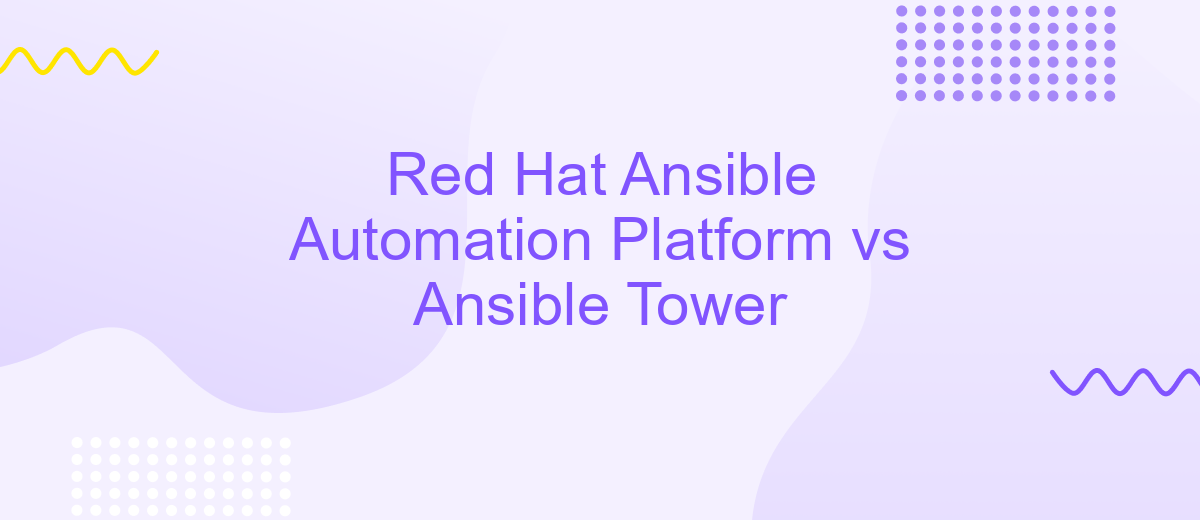Red Hat Ansible Automation Platform vs Ansible Tower
In the rapidly evolving world of IT automation, choosing the right tools can significantly impact efficiency and scalability. Red Hat Ansible Automation Platform and Ansible Tower are two prominent solutions that streamline automation processes. This article explores the differences and advantages of each, helping organizations make informed decisions to optimize their automation strategies and enhance their infrastructure management capabilities.
Introduction
In the rapidly evolving world of IT automation, Red Hat Ansible Automation Platform and Ansible Tower stand out as two pivotal tools that streamline and enhance the management of complex infrastructures. While both are integral to the automation landscape, they serve distinct roles and offer unique features tailored to different organizational needs. Understanding these differences is crucial for businesses aiming to optimize their IT operations and achieve seamless automation.
- Red Hat Ansible Automation Platform: A comprehensive suite designed for end-to-end automation, providing tools and services for implementing enterprise-wide automation strategies.
- Ansible Tower: A powerful web-based interface built to complement Ansible, offering enhanced control, security, and delegation capabilities for managing automation tasks.
Choosing between Red Hat Ansible Automation Platform and Ansible Tower depends on various factors, including the scale of automation required, the complexity of IT environments, and specific organizational objectives. By examining the features, benefits, and limitations of each, businesses can make informed decisions that align with their automation goals and drive efficiency across their operations. As automation continues to transform IT landscapes, selecting the right tool becomes a strategic imperative for success.
Key Differences

Red Hat Ansible Automation Platform and Ansible Tower serve distinct purposes within the automation ecosystem, each offering unique features. Ansible Tower is primarily focused on providing a web-based interface for managing Ansible projects, offering role-based access control, job scheduling, and real-time job status updates. It acts as a central hub for managing complex deployments and orchestrations, making it suitable for environments that require detailed oversight and control.
On the other hand, the Red Hat Ansible Automation Platform encompasses a broader suite of tools beyond Ansible Tower. It includes automation content collections, analytics, and certified content, enabling a more comprehensive automation strategy. This platform is designed for scalability and integrates seamlessly with various services and APIs, such as ApiX-Drive, to facilitate streamlined integrations and automation workflows across multiple systems. While Ansible Tower is a component of the Ansible Automation Platform, the latter provides a holistic solution for enterprise-level automation needs, offering enhanced capabilities and support.
Pricing and Licensing

When considering the pricing and licensing of Red Hat Ansible Automation Platform and Ansible Tower, it's essential to understand the differences and options available. Both platforms offer powerful automation capabilities, but their pricing structures can vary significantly based on the features and support levels required by your organization.
- Red Hat Ansible Automation Platform: This platform is typically offered as a subscription-based service. Pricing is often determined by the number of nodes or hosts managed, with additional costs for premium support and advanced features.
- Ansible Tower: Ansible Tower, now integrated into the Ansible Automation Platform, was previously available as a standalone product. Its pricing was also subscription-based, with costs based on the number of nodes and additional features like role-based access control and job scheduling.
Choosing between these options requires a careful assessment of your automation needs and budget. It's advisable to contact Red Hat or authorized resellers for detailed pricing information and to explore potential discounts or bundled offerings that may be available. Understanding the licensing terms is crucial for ensuring compliance and maximizing the return on investment in your automation infrastructure.
Use Cases

Red Hat Ansible Automation Platform and Ansible Tower each serve distinct purposes in the realm of IT automation, providing valuable use cases for organizations of varying sizes and needs. Ansible Tower, now part of the broader Ansible Automation Platform, primarily focuses on providing a streamlined user interface and centralized control for managing Ansible deployments. It is particularly beneficial for teams seeking to automate complex workflows and enhance collaboration across IT departments.
On the other hand, Red Hat Ansible Automation Platform offers a more comprehensive suite of tools designed for enterprise-grade automation. It extends beyond the capabilities of Ansible Tower by integrating advanced analytics, content management, and automation execution environments. This makes it ideal for organizations that require a scalable and robust automation solution to manage diverse IT ecosystems.
- Centralized management of Ansible playbooks and inventories.
- Role-based access control for secure automation operations.
- Integrated logging and auditing for compliance and troubleshooting.
- Automation of repetitive tasks to increase operational efficiency.
In summary, while Ansible Tower provides essential automation management features, the Red Hat Ansible Automation Platform offers a more extensive framework for enterprises aiming to achieve comprehensive automation across their IT infrastructure. Selecting the right solution depends on the specific operational requirements and scalability needs of the organization.


Recommendation
When deciding between Red Hat Ansible Automation Platform and Ansible Tower, it's essential to consider your organization's specific needs and existing infrastructure. Red Hat Ansible Automation Platform offers a comprehensive suite of tools that can streamline and automate complex IT environments. It is ideal for enterprises seeking a robust solution with extensive support and integration capabilities. On the other hand, Ansible Tower is suited for organizations that require a more straightforward, user-friendly interface and basic automation features. It is perfect for smaller teams or those new to automation.
For organizations looking to enhance their automation capabilities with seamless integration, leveraging services like ApiX-Drive can be beneficial. ApiX-Drive simplifies the connection between various applications and services, allowing for smoother workflows and data synchronization. This can be particularly advantageous for businesses aiming to integrate Ansible solutions with other software platforms efficiently. Ultimately, the choice between Red Hat Ansible Automation Platform and Ansible Tower should align with your automation goals, team expertise, and integration requirements to ensure optimal performance and scalability.
FAQ
What is the difference between Red Hat Ansible Automation Platform and Ansible Tower?
Can I use Ansible Tower separately from the Red Hat Ansible Automation Platform?
How does the Red Hat Ansible Automation Platform enhance automation capabilities?
Is there a way to integrate third-party services with Ansible Tower?
What are the licensing options for Red Hat Ansible Automation Platform and Ansible Tower?
Time is the most valuable resource in today's business realities. By eliminating the routine from work processes, you will get more opportunities to implement the most daring plans and ideas. Choose – you can continue to waste time, money and nerves on inefficient solutions, or you can use ApiX-Drive, automating work processes and achieving results with minimal investment of money, effort and human resources.

